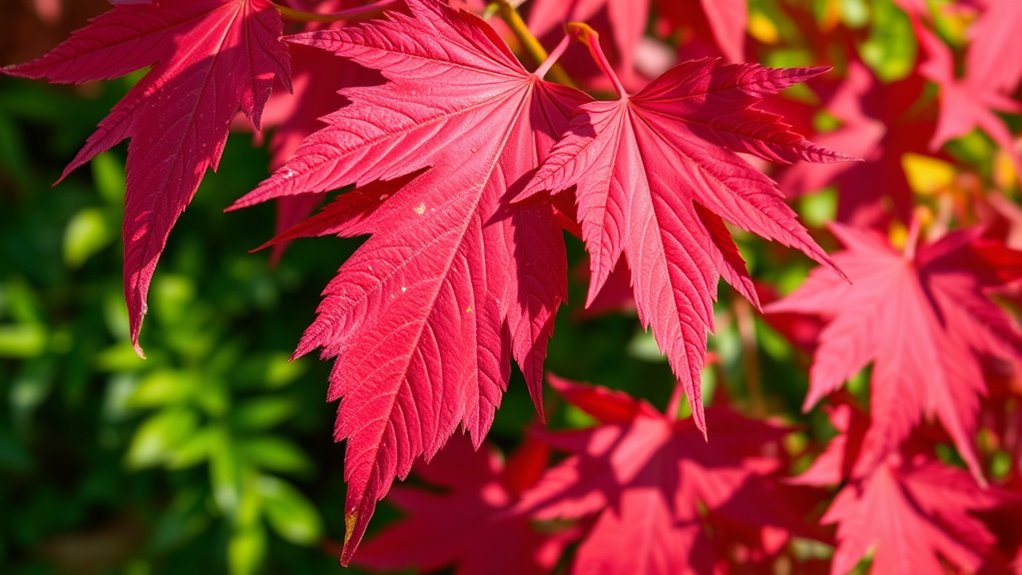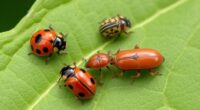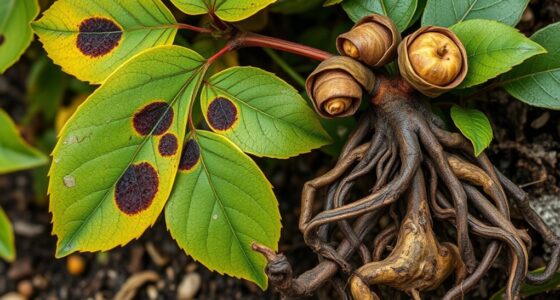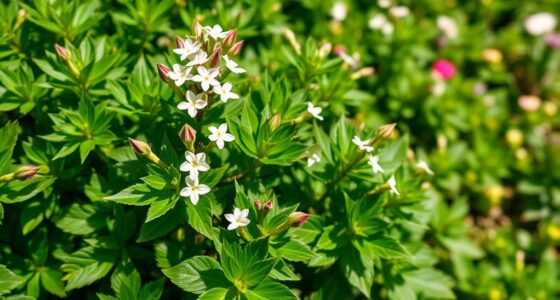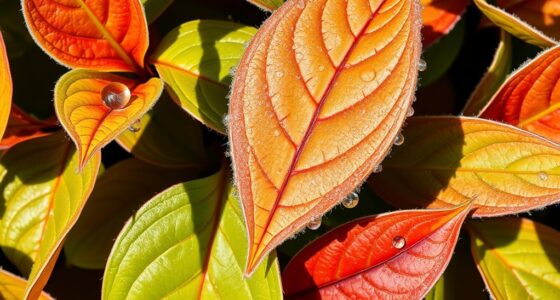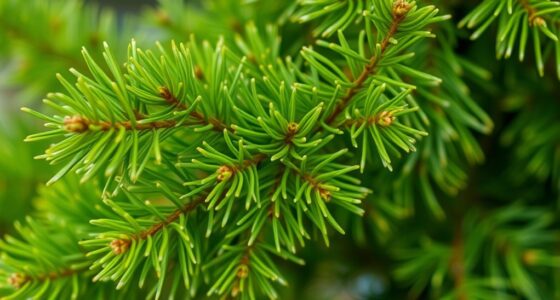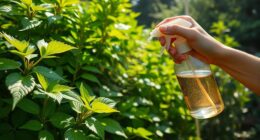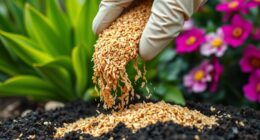If your Japanese maple leaves are drooping, look for signs of heat stress, such as scorched or curling edges, and verify the tree is well-hydrated by checking soil moisture levels. Also, examine for signs of disease, like spots or wilting, and consider possible pests. Properly diagnosing these issues involves observing your tree’s environment and health, so explore further to learn how to effectively care for your plant and prevent future problems.
Key Takeaways
- Inspect leaves for wilting, curling, scorch marks, or browning to identify heat or dehydration stress.
- Check soil moisture by feeling 2 inches deep; soil should be moist but not soggy.
- Look for signs of pests, fungal spots, or lesions on bark to diagnose disease or pest-related issues.
- Assess environmental factors like excessive sun exposure or poor watering practices contributing to stress.
- Remove damaged branches and ensure proper watering, fertilizing, and mulching for recovery.
Recognizing Signs of Heat Stress in Japanese Maples
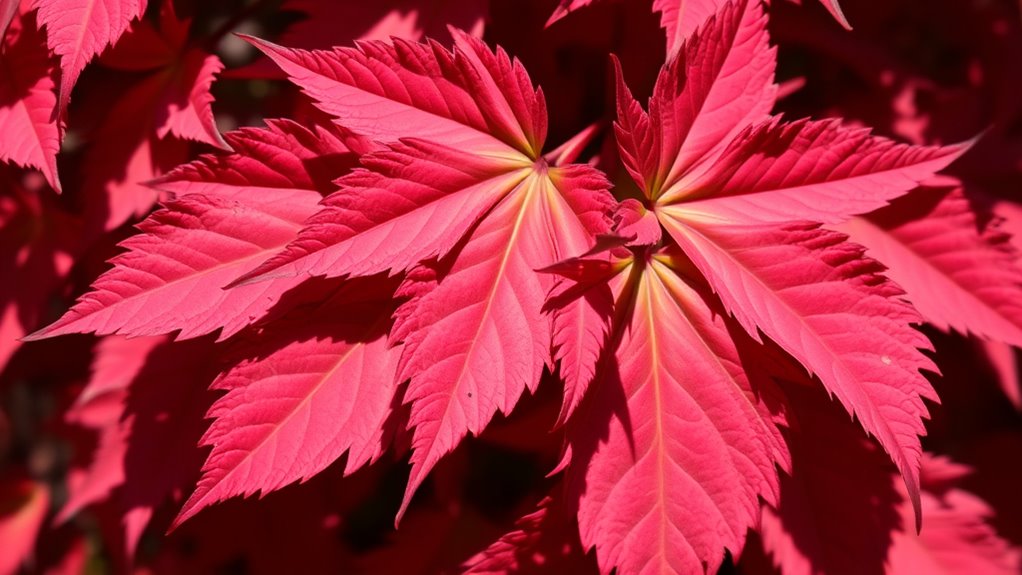
When Japanese maples are exposed to excessive heat, they often show clear signs of stress that you can easily spot. Leaves may wilt, curl, or become scorched at the edges, indicating dehydration and heat overload. To help your tree recover, consider proper pruning techniques—removing damaged or dead branches encourages healthy growth and airflow. Additionally, applying fertilizer appropriately can support nutrient uptake, strengthening the tree against further stress. During hot weather, avoid heavy pruning that exposes more foliage to the sun, which can worsen the damage. Instead, focus on light, strategic cuts to reduce stress. Keep an eye on leaf color and texture, as these are primary indicators of heat-related distress. Recognizing these signs early helps you take immediate action to protect your Japanese maple. Proper hydration and monitoring for signs of heat stress can further prevent long-term damage. Additionally, understanding the effects of heat on plant physiology can help you implement more effective preventative measures.
Assessing Watering Practices and Moisture Levels
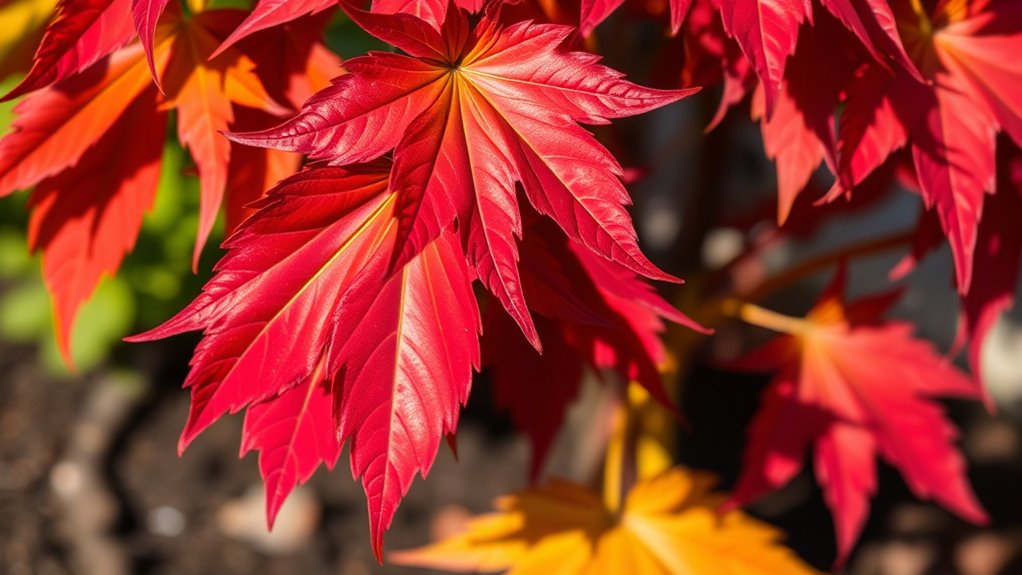
Proper watering is essential for keeping your Japanese maple healthy, especially during periods of heat stress. To assess your watering practices, start by checking the soil moisture. Stick your finger about two inches into the soil; it should feel moist but not soggy. Ensuring soil aeration is vital, as compacted soil hampers water absorption and root health. When watering, aim for deep, infrequent sessions to promote strong roots. Avoid overwatering, which can lead to root rot. Additionally, consider how fertilizer application affects moisture levels; excessive fertilizer can increase water demand and stress the tree. Regularly monitor soil moisture and adjust watering accordingly to maintain consistent moisture. Proper watering, combined with good soil aeration and mindful fertilizer use, helps prevent drooping leaves caused by water stress. Recognizing signs of water stress early can help you take corrective action before damage occurs. Incorporating techniques from soil moisture management can further optimize your watering routine. For optimal health, also ensure your soil has proper drainage to prevent waterlogging and related issues.
Identifying Disease Symptoms and Damage
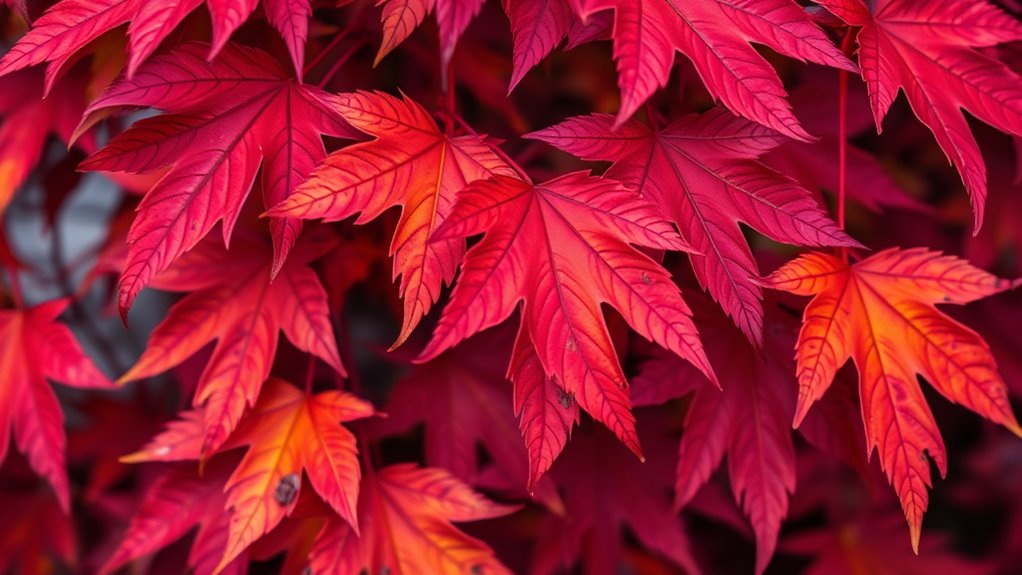
Since disease symptoms can closely resemble watering issues, it’s important to carefully examine your Japanese maple for signs of damage. Look for telltale signs like leaf scorch, which causes browning or crisp edges, or irregular spots indicating fungal infections. Check for pest infestation, such as tiny insects or webs, which can weaken leaves and spread disease. You might notice wilting, discolored foliage, or unusual lesions on the bark. Damage can also include:
- Browning or curling leaf edges
- Sticky residue or honeydew from pests
- Discolored or speckled leaves
- Soft, rotting spots on stems or branches
- Visible insects or webs
Being aware of disease symptoms and how they manifest helps you diagnose the problem accurately. Identifying these symptoms early helps you determine if disease or pests are causing the drooping, so you can take appropriate action. Additionally, environmental factors like heat stress from high temperatures or inadequate watering can also contribute to leaf drooping, making it essential to consider all possible causes. Recognizing plant health indicators such as leaf color changes and texture can further assist in diagnosing issues promptly.
Differentiating Between Environmental and Biological Causes
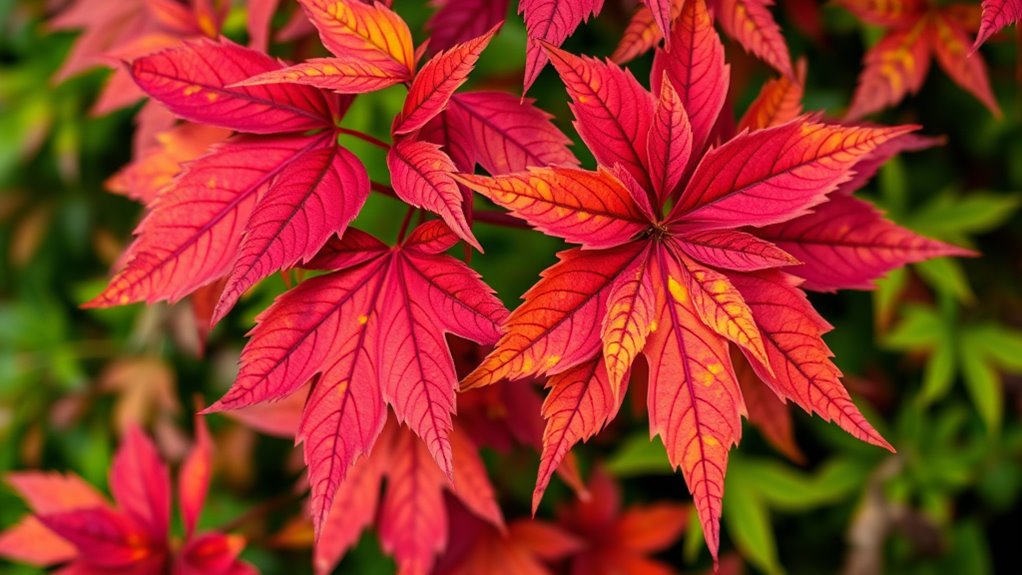
Distinguishing between environmental stressors and biological factors is essential for diagnosing drooping leaves on your Japanese maple. Environmental issues often relate to soil pH, which can affect nutrient uptake; if the soil is too acidic or alkaline, the tree might struggle and show stress symptoms. Overexposure to heat or improper watering also causes drooping, indicating environmental stress. On the other hand, biological causes like pest infestation directly damage leaves and stems. Signs of pests include holes, sticky residue, or visible insects, which help identify biological problems. By examining soil pH levels and inspecting for pests, you can determine whether environmental factors or pests are causing your tree’s drooping leaves, guiding you toward appropriate treatment or adjustments. Additionally, understanding how soil conditions influence plant health can help prevent future stress issues, emphasizing the importance of proper irrigation techniques and soil testing. Regularly monitoring watering practices ensures the tree receives the right amount of moisture, reducing stress related to drought or overwatering.
Implementing Proper Care Strategies to Restore Health
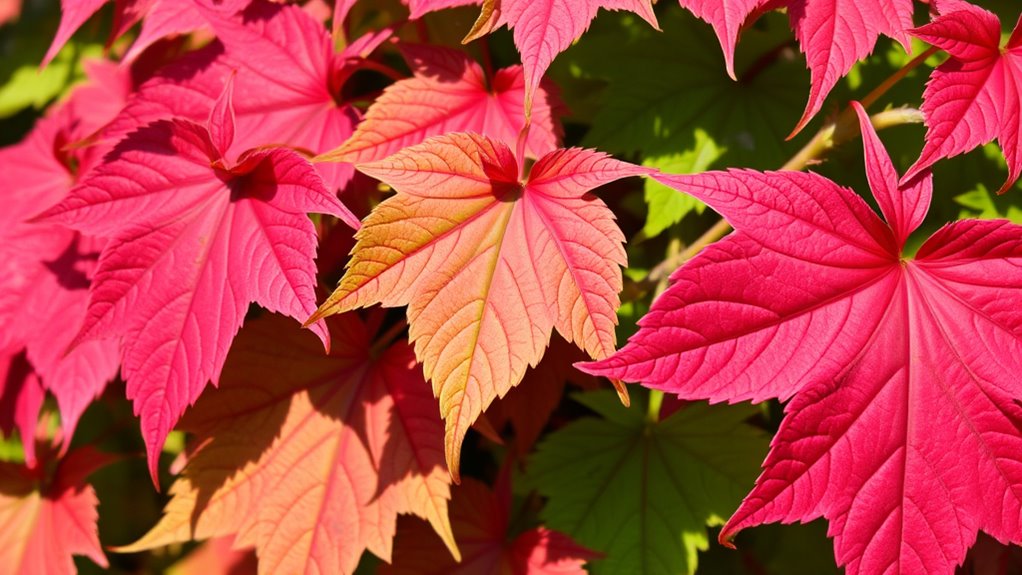
Addressing drooping leaves on your Japanese maple requires implementing targeted care strategies to restore its health. Start with proper pruning techniques to remove dead or overgrown branches, encouraging better airflow and growth. Adjust fertilization methods by using a balanced, slow-release fertilizer in early spring to promote healthy development. Guarantee consistent watering—deeply soaking the soil when dry—to prevent stress from drought or overwatering. Mulch around the base to maintain soil moisture and temperature. Regularly monitor for pests or disease signs, acting promptly if issues arise. By applying these strategies, you help your Japanese maple recover strength and vitality. Additionally, incorporating appropriate wicking materials can help maintain consistent soil moisture, supporting overall plant health. Ensuring proper soil drainage is also crucial to prevent root rot and other issues caused by waterlogging. Considering regional climate conditions can further optimize your care routine and prevent stress factors that contribute to drooping.
Frequently Asked Questions
Can Japanese Maples Recover From Prolonged Drought Conditions?
If your Japanese maple faces prolonged drought, recovery depends on its drought tolerance and your watering strategies. While these trees prefer consistent moisture, they can sometimes recover if you start deep watering promptly, encouraging root growth. However, extended drought stress might cause lasting damage. To help your tree bounce back, guarantee you water deeply and regularly, especially during dry spells, and consider mulching to retain soil moisture.
Which Specific Diseases Cause Leaf Drooping in Japanese Maples?
When it comes to drooping leaves, you’re really fighting an uphill battle if fungal infections or pest infestations are the culprits. Fungal diseases like verticillium wilt and leaf scorch can cause leaves to wilt and droop, while pests like aphids and scale insects feed on sap, weakening the tree. Recognize these signs early, and you can take action before the problem grows worse—don’t let it get the better of you.
How Does Soil Ph Affect Japanese Maple Health?
Soil pH substantially impacts your Japanese maple’s health by affecting soil acidity and nutrient availability. If the soil is too acidic or too alkaline, it can hinder the tree’s ability to absorb essential nutrients, leading to stress and drooping leaves. Ensuring the soil pH is balanced, ideally around 5.5 to 6.5, promotes best nutrient uptake, keeping your maple healthy and vibrant. Regular testing helps maintain perfect conditions.
Are There Resistant Varieties to Japanese Maple Leaf Stress?
You might wonder if resistant cultivars exist with better stress tolerance. Yes, some resistant cultivars are bred specifically to handle environmental stresses like heat, drought, and disease. These varieties often have enhanced resilience, reducing the likelihood of leaf drooping or damage. Choosing these resistant cultivars can help you maintain healthier Japanese maples, especially in challenging conditions, and guarantee your tree stays vibrant and stress-free longer.
What Are Natural Remedies for Japanese Maple Leaf Drooping?
When your Japanese maple’s leaves droop, it’s like the tree’s cry for help. You can try organic treatments like compost teas or neem oil to boost health naturally. Proper pruning techniques also help improve airflow and reduce stress. Remember, gentle care is key—avoid overwatering or drought. By nurturing your tree with these natural remedies, you encourage resilience and vibrant growth, turning drooping into a sign of recovery rather than distress.
Conclusion
So, next time your Japanese maple’s leaves droop like they’re auditioning for a soap opera, remember—it’s probably just craving some water, avoiding the sun, or battling a sneaky disease. Don’t let it become the neighborhood’s drama queen. With a little attention and care, your tree can bounce back, looking stunning enough to make your neighbors jealous. After all, who needs a fancy garden when you’ve got a resilient, drama-free Japanese maple?
